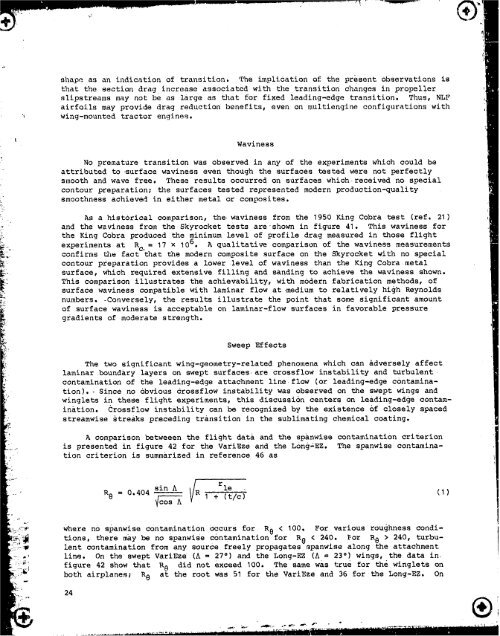NASA Technical Paper 2256 - CAFE Foundation
NASA Technical Paper 2256 - CAFE Foundation
NASA Technical Paper 2256 - CAFE Foundation
Create successful ePaper yourself
Turn your PDF publications into a flip-book with our unique Google optimized e-Paper software.
shape as an indication of transition. The implication of the present observations is<br />
that the section drag increase associated with the transition changes in propeller<br />
slipstreams may not be as large as _lat for fixed leading-edge transition. Thus, NLF<br />
airfoils may provide drag reduction benefits, even on multiengine configurations with<br />
wing-mounted tractor engines.<br />
Waviness<br />
No premature transition was observed in any of the experiments which could be<br />
attributed to -surface waviness even though the surfaces tested were not perfectly<br />
smooth and wave free, These results occurred on surfaces which received no special<br />
contour preparation; the surfaces tested represented modern production-quality<br />
smoothness achieved in either metal or composites.<br />
As a historical comparison, the waviness from the 1950 King Cobra test (ref. 21)<br />
and the waviness from the Skyrocket tests areshown in figure 41. This waviness for<br />
the King Cobra produced the minimum level of profile drag measured in those flight<br />
experiments at Re. = 17 × 106 • A qualitative comparison of the waviness measurements<br />
confirms _ie fact that the modern composite surface on the Skyrocket with no special<br />
contour preparation provides a lower level of waviness than the King Cobra metal<br />
surface, which required extensive filling and sanding to achieve the waviness shown.<br />
This comparison illustrates the achievability , with modern fabrication methods, of<br />
surface waviness compatible with laminar flow at-medium to relatively high Reynolds<br />
numbers. -Conversely, the results illustrate the point that some significant amount<br />
of surface waviness is acceptable on laminar-flow surfaces in favorable pressure<br />
gradients of moderate strength.<br />
Sweep Effects<br />
The two significant wing-geometry-related phenomena which can adversely affect<br />
laminar boundary layers on swept surfaces are crossflow instability and turbulent<br />
contamination of the leading-edge attachment line flow (or leading-edge contamina-<br />
tion). - Since no Obvious crossflow instability was observed on the swept wings and<br />
winglets in these flight experiments, this discussion centers on leading-edge contam-<br />
ination. Crossflow instability can be recognized by the existence of closely spaced<br />
streamwise streaks preceding transition in the sublimating chemical coating.<br />
A comparison betweeen the flight data and the spanwise contamination criterion<br />
is presented in figure 42 for the variEze and the L0ng-EZ. The spanwise contamina-<br />
tion criterion is summarized in reference 46 as<br />
R 8 = 0.404 sin A _R rle<br />
A I + (t/c) (I)<br />
Where no spanwise contamination occurs for R 0 < 100. For various roughness condi-<br />
tions, there may be no spanwise contamination for R o < 240. _or R 0 > 240, turbulent<br />
contamination from any source freely propagates spanwise along the attachment<br />
line. On the swept VariEze (A = 27 °) and the Long-EZ (A = 23 ° ) wings, the data in.<br />
figure 42 show that R o did not exceed 100. The same was true for thewinglets on<br />
both airplanes; R@ at the root was 51 for the VariEze and 36 for the Long-EZ. On<br />
24

















